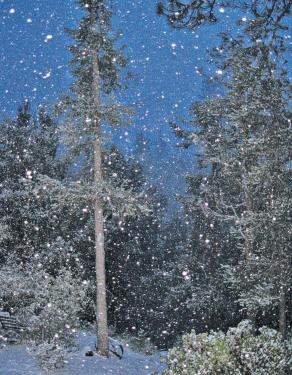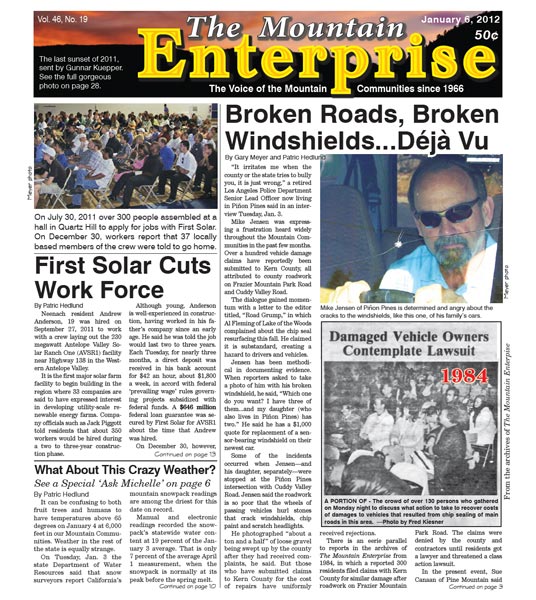
Peter S. Burke of Pine Mountain took this photo of snowfall on April 8, 2011. It is a reminder that we may have hard winter weather yet ahead, despite the two weeks of mild temperatures without precipitation over the holidays.
See a Special ‘Ask Michelle’ Below
By Patric Hedlund
It can be confusing to both fruit trees and humans to have temperatures above 65 degrees on January 4 at 6,000 feet in our Mountain Communities. Weather in the rest of the state is equally strange.
On Tuesday, Jan. 3 the state Department of Water Resources said that snow surveyors report California’s mountain snowpack readings are among the driest for this date on record.
Manual and electronic readings recorded the snowpack’s statewide water content at 19 percent of the January 3 average. That is only 7 percent of the average April 1 measurement, when the snowpack is normally at its peak before the spring melt.
Despite the dry conditions, water managers remain cautiously optimistic about this year’s water supply.
“Fortunately, we have most of the winter ahead of us, and our reservoir storage is good,” said Department of Water Resources (DWR) Director Mark Cowin.
In fact, last year the largest and deepest 24-hour snowfall in this region took place on March 20, the first day of spring. There were still intermittent snows two months later. The first day of spring snowfall brought down electricity and telephone lines throughout the mountain. Depending on elevation, two to five feet fell in the communities below Mount Pinos in that one 24-hour period.
According to state agricultural crop weather forcasters, “a persistent, high pressure ridge” was the dominant feature of last week’s weather.
The report explains that “this ridge shielded Southern California completely from several weather systems which hit the Pacific Northwest during the week….”
In Southern (and Central) California, conditions were dry and mild, with humidity readings below 10 percent and above normal temperatures reported statewide.
Still, initial estimates predict the state water project will be able to deliver 60 percent of the water requested for urban households and agricultural irrigation.
The DWR report underscores that calendar year 2011 illustrates how weather- driven water supply conditions can dramatically change. The initial 2011 estimate was that only 25 percent of the slightly more than 4 million acre-feet requested could be delivered. As winter took hold and storms swept the state, a near-record snowpack and heavy rains resulted in deliveries of 80 percent of requests in 2011.
In 2010 the final allocation was 50 percent; 40 percent in 2009; 35 percent in 2008; and 60 percent in 2007. The last 100 percent allocation—difficult to achieve even in wet years because of Delta pumping restrictions to protect threatened and endangered fish—was in 2006.
ASK MICHELLE
Our surprisingly warm winter weather has local gardeners concerned, so here is a special, emergency "Ask Michelle" column.-Editor
January 2, 2012
Dear Michelle,
I am wondering what we are to do with our fruit trees that are about to blossom out-only about three months early-due to this dry and warm weather.
When the inevitable snow comes, can I "save" what might be my summer fruit by wrapping the branches in plastic? My trees are quite small.
Carolyn
Dear Carolyn,
There is little that can be done to stop Mother Nature when she wields her powers.
Plastic will transfer cold very readily, so it is the least preferred method of frost protection. Fabric is best but I don’t know how long you could keep the branches wrapped once the cold returns. They must have some sunlight to stay healthy. That would mean wrapping and unwrapping each branch every few days.
I have in the past attempted to cover my small trees at night with a tent of lightweight fabric or frost cover, but it is difficult to keep in place if the winds blow. If it snows the tent can collapse under the weight and damage the branches. If the trees are small, that might be a solution but be wary of snow accumulation.
Sometimes, fruit buds begin to swell during warm weather and may look like they’re going to bloom but will stop short of blossoming. Peaches, plums and apricots are the most susceptible to warm weather. Apples and pears stay dormant longer and would not bloom this early. Always try to select varieties of fruit trees suitable for our zones: 5,6,7 depending on where you live.
We’re all in a daze with this warm weather. This could be one of those rare winters where it stays warm. If rain stays away, be sure to water at least once or twice this winter when the ground is thawed. This is especially important for newly planted trees. I actually planted daffodils today because the ground was so nicely thawed. Next thing you know, I’ll be breaking out my flip-flops!
Good luck. I truly hope this helps. – Michelle Maga
This is part of the January 06, 2012 online edition of The Mountain Enterprise.
Have an opinion on this matter? We'd like to hear from you.


